The items and people who shaped SFA
Written and Curated by Chris Cotton '21
Introduction by Alyssa Faykus '19
Photos by Lizeth Garcia
History lives in us and in our everyday objects, leaving decades of memories, knickknacks, events and historic moments to recall fondly during SFA's centennial anniversary.
A catalogue of these objects handpicked and curated by Chris Cotton '21, university archives and research coordinator in SFA's East Texas Research Center, is shared below. Some of these items may look familiar to our alumni while others will give a glimpse into how the first Lumberjack cohorts started the traditions our current students still enjoy, even if they look different today.
The ETRC collects, preserves, maintains and makes archival materials available to support the educational and research goals of SFA and the surrounding East Texas community. If you have items of historical significance you would like to donate to the archive, contact the ETRC at 936.468.4100 or asketrc@sfasu.edu for general East Texas donations or Cotton at 936.468.1506 or christopher.cotton@sfasu.edu for SFA-related donations.
Twenty-three reasons why
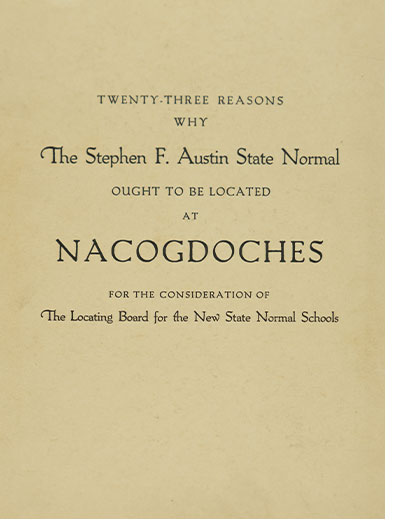
This document was created in 1917 by the Citizens Committee of Nacogdoches to try to persuade members of the state locating board to place the Stephen F. Austin Normal College in their town. (Normal colleges were the names given to teachers colleges in the late 19th and early 20th century.) A 1915 law authorized the creation of a school "east of the 96th meridian" named Stephen F. Austin Normal College. This legislation was challenged, amended and passed as House Bill No. 72 in 1917.
This bill meant the Texas Legislature approved the creation of the school but had not yet set a location. The other locations considered were Longview, Marshall, Beaumont, Texarkana, Athens and Lufkin. Ultimately the 23 Reasons booklet, along with the hard work of the Citizens Committee and business leaders, convinced the state that Nacogdoches was the best location for the college.
Pine Tree Hymn
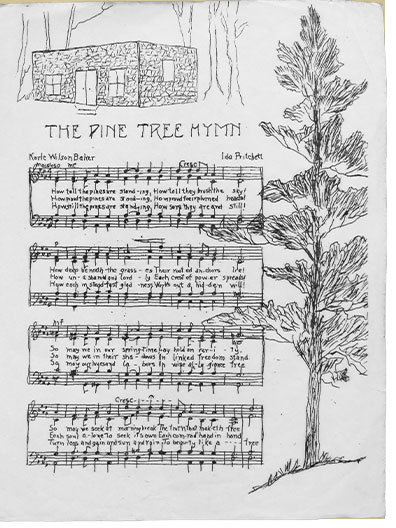
"The Pine Tree Hymn" is considered the first official school song with words written by Karle Wilson Baker and music composed by Ida Pritchett. Baker was one of the notable faculty members during SFA's early years and was considered Texas' premier poet. She wrote the lyrics to "The Pine Tree Hymn" at the urging of SFA's first president, Dr. Alton W. Birdwell.
Birdwell enjoyed the poem so much that he asked Pritchett to reach out to musicians in Texas to compose music to the words. The best composition would receive a small prize; however, the submissions received were not acceptable. The university then asked Pritchett to compose the music.
J.T. Cox, SFA's band director, scaled the song up to be played by a large band. The song was played at commencements and public functions as the school hymn.
Commencement Programs from First Commencement
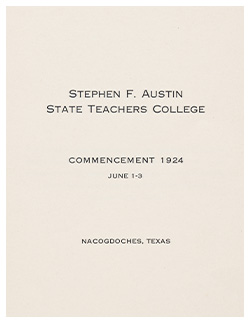
SFA's first commencement took place in 1924. Even though SFA had only been open one year, Birdwell presented certificates and diplomas to 115 students in the sub-college. The sub-college served as a way for students who did not receive an 11th or 12th grade primary education to prepare for college. At the time, 11th and 12th grade educations were not required by the state but were deemed necessary for entering a college or university. More than half of the students at SFA were in the sub-college when SFA opened. Although the sub-college was later discontinued, the program was vital to SFA's early success.
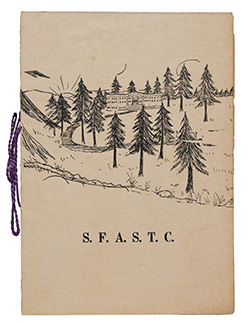
The first official commencement to confer college degrees occurred in August 1925.
1937 Homecoming Queen Crown
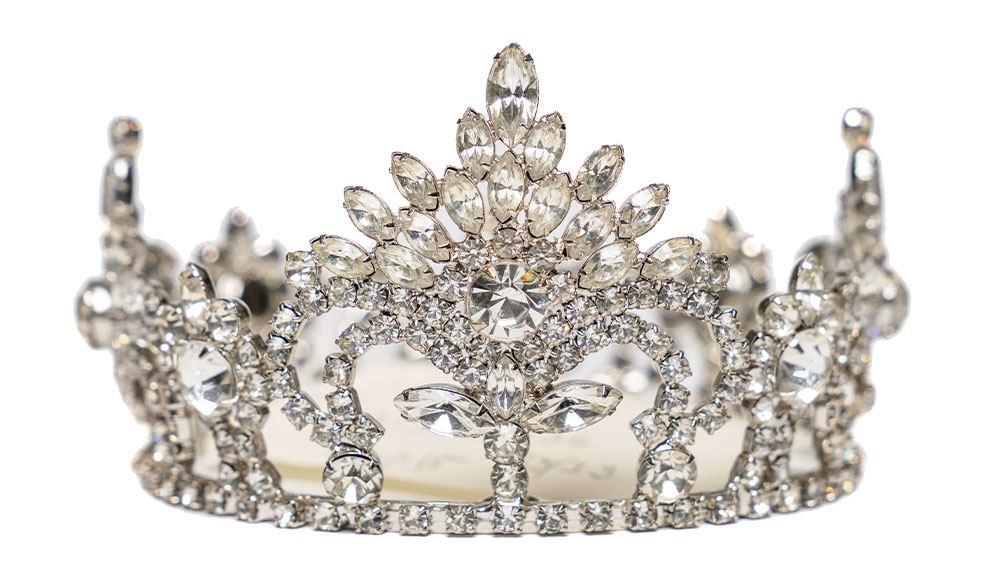
Helen Shattuck '38 wore this crown when she was named Miss SFA in 1937, the equivalent of Homecoming queen in the 1930s. Homecoming was originally celebrated in the spring by the Ex-Students Association, a forerunner to the Alumni Association. The first large-scale Homecoming occurred in May 1930 when more than 1,000 people attended the festivities. In the summer of 1935, the Ex-Students Association decided to add a Homecoming celebration in the fall for SFA's annual game against Sam Houston State University. This started the fall tradition we now know as Homecoming.
The 1935 event had a parade, pep rallies, numerous bonfires, dances and the coronations of class favorites. The first year an official Homecoming queen title was created and documented in the Stone Fort yearbook was 1940.
Axe Handle from the Sawyers

This axe handle belonged to Orville Todd '47 who served as vice president of the Sawyers in 1947. Organized in the fall of 1927, the Sawyers were one of the first social clubs on campus and creators of the axe handle tradition, which was originally limited only to members of the Sawyers. Axe handles were uniquely decorated to show each member's personality.
The group also started the tradition of pounding axe handles at sporting events. Their motto was "For the Lumberjacks and SFA — win, lose or draw." The Sawyers would later become Delta Sigma Phi fraternity in 1961. Todd's axe handle shows the years he was in school but uniquely also shows the time he served in World War II.
Pine Burr Jumpsuit
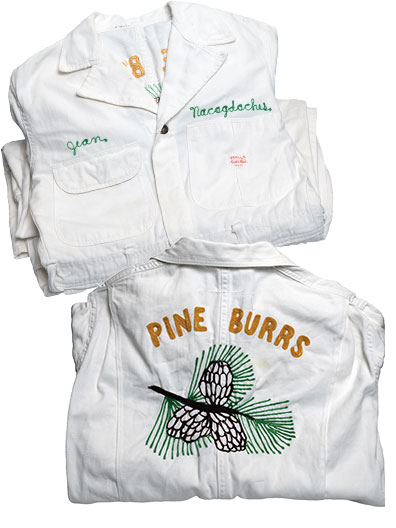
This jumpsuit, donated by Jean Colley '53 of Henderson, was a popular item for members of the Pine Burrs to wear. The Pine Burrs started in the fall of 1929 and were committed to promoting service on campus, boosting the college and aiding the student body as a whole. The ladies' organization frequently hosted dances or socials on campus in conjunction with the Sawyers. Members of the Pine Burrs were often selected as Homecoming queens, and they would have a float for every Homecoming parade.
Two documented pledge traditions that occurred in the group were to have new members roll a mothball or peanut down Vista Drive or to have pledges take off their shoes and fling them on the field at halftime of the first football game. The Pine Burrs became Chi Omega sorority in 1963.
First Edition of The Pine Log
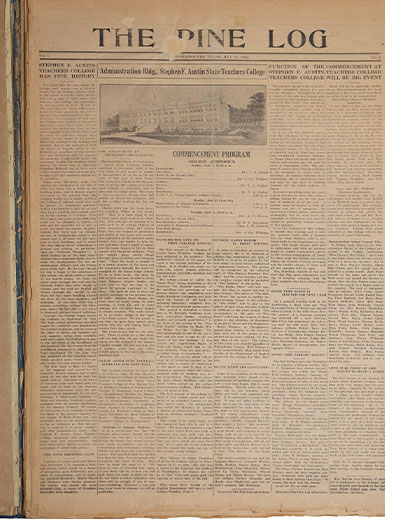
The Pine Log's name was proposed by Virginia Broadfoot, the women's physical education teacher, as a play on words. The name's double meaning — a literal pine log and a detailed record — was voted on by faculty and staff who agreed it was a good name.
The first edition, pictured, was published May 31, 1924. Mary Edwards '27 was the paper's first editor, and her first editorial told students the purpose of the student newspaper. "The purpose of The Pine Log is to give the news pertaining to the community. It will try to have a college view — to publish the worthwhile things in all student activities, to present in an authoritative, if not official manner, the student endeavors, the faculty plans, and the hopes of the friends of the college," Edwards wrote in the first edition.
First Edition of Stone Fort
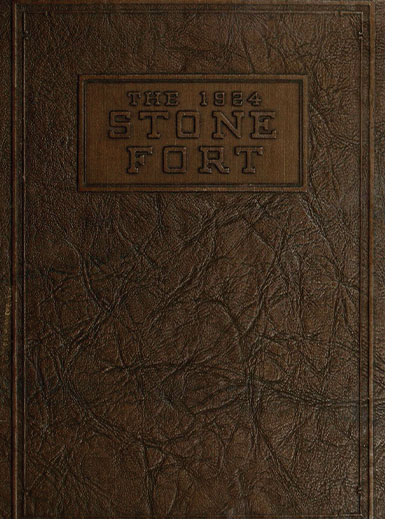
First printed in 1924, the Stone Fort name was chosen for the SFA yearbook because the students felt the historic Stone Fort represented the sacrifices, patriotism and pioneering spirit of the early settlers of Nacogdoches.
The Stone Fort committee said the following about the inaugural issue of the yearbook: "Our own Stone Fort is a pleasant reminder of our first year at Stephen F. Austin State Teachers College, a year through whose sacrifices and work and comradeship we have advanced a step in the direction of a better civilization and education for ourselves and our beloved Texas."
The Stone Fort has been published every year of SFA's existence except for the 1933 and 1934 class years due to lack of funds during the Great Depression. However, in 1958, an annual was produced with memories and reflections to document the class of 1933's missing academic year as a commemoration of its 25th anniversary. Learn more about SFA's student publications in our Read Between the Lines story.
Spirit of SFA 45 Vinyl Record, Including "Make Way for SFA"
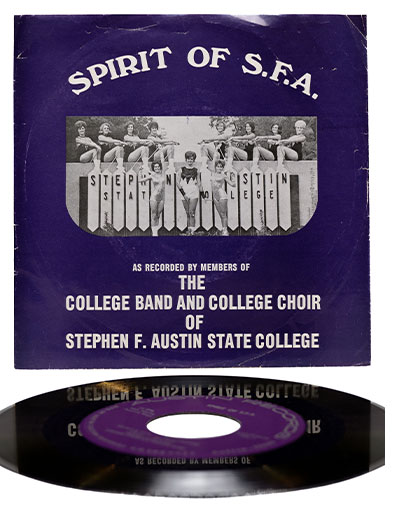
"Make Way for SFA" is SFA's first fight song and the second officially recognized song at the university, following Karle Wilson Baker's "Pine Tree Hymn." The song was created by Fred Waring, a well-known composer during the 1930s, along with his musical group, the Pennsylvanians. Waring and the Pennsylvanians were considered one of the most popular musical acts in the country. Waring's popularity among college students was due to his evening radio show "Pleasure Time" sponsored by Chesterfield Cigarettes.
A campaign led by the Sawyers worked to get Waring to compose a song for SFA. He debuted the fight song during his radio show Jan. 12, 1940. This would be the university's fight song until it was replaced by the "SFA Fight Song" in the late 1970s. The "SFA Fight Song" was expanded in 2022 with the addition of multiple stanzas.
Student Scrapbooks
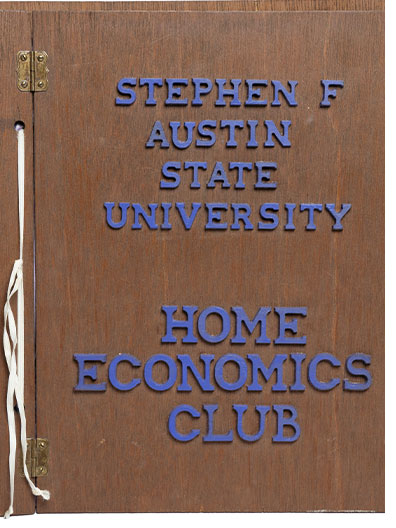
Creating scrapbooks for organizations across campus is a long-standing tradition that current students still enjoy, echoing the spirit of the Lumberjacks who came before them. Student scrapbooks have always been a popular way for student organizations and clubs to document their history.
This scrapbook is from the Ellen Richards Home Economics Club. The club was started in 1926 on SFA's campus, making it one of the university's oldest clubs. In 1932, members added the name "Ellen Richards" to the club's title in honor of the pioneering chemist, educator and founder of home economics. The club put on various home economics programs for the campus community, including sponsoring coffee hours on Homecoming day, entering floats in the Homecoming parade; hosting a Christmas party, as well as fall and spring picnics; and aiding with the banquets for the Ex-Students Association in the spring.
The club is still in existence today as the Family and Consumer Sciences Student Organization, making it one of SFA's oldest active student organizations.
Women's Auxiliary Army Corps Scrapbook
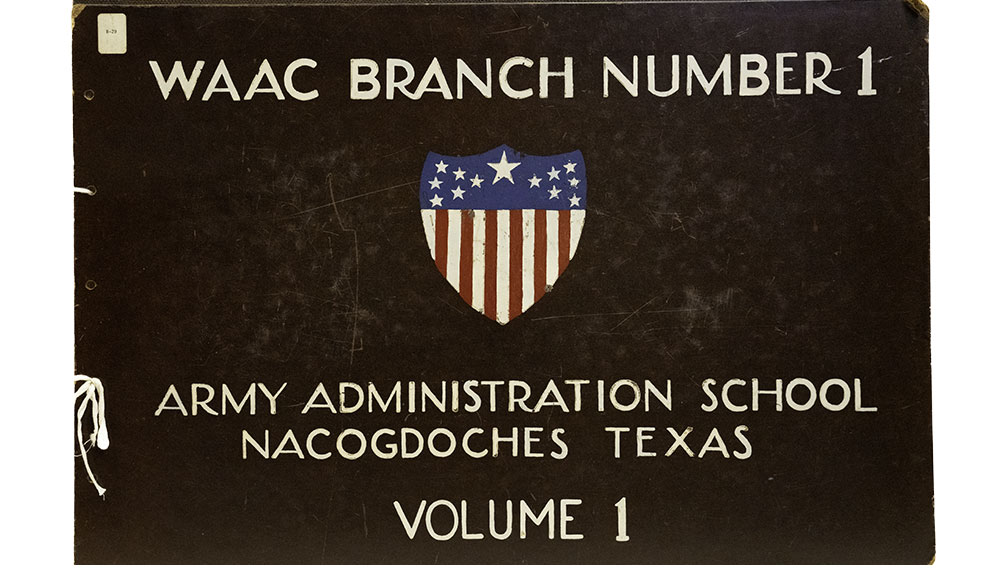
The Women's Auxiliary Army Corps school operated on campus from 1943 to 1944. Due to young men enlisting in World War II, SFA's enrollment was drastically reduced. SFA's second president, Dr. Paul Boynton, arranged for the first Women's Auxiliary Army Corps administration school in the nation to be located at SFA.
The purpose of the WAAC was to release men for other military duties while women served in a military administrative capacity during the war. This brought people from all over the United States in groups of 200 to SFA's campus. Members were housed in campus dormitories and attended their training classes in the Austin Building. The corps school both contributed to the war effort and helped keep the university afloat until the end of World War II. The return of veterans after the war ushered in a new era of prosperity to SFA. This scrapbook holds a collection of articles about the WAAC.
Freshman Beanie, 1950
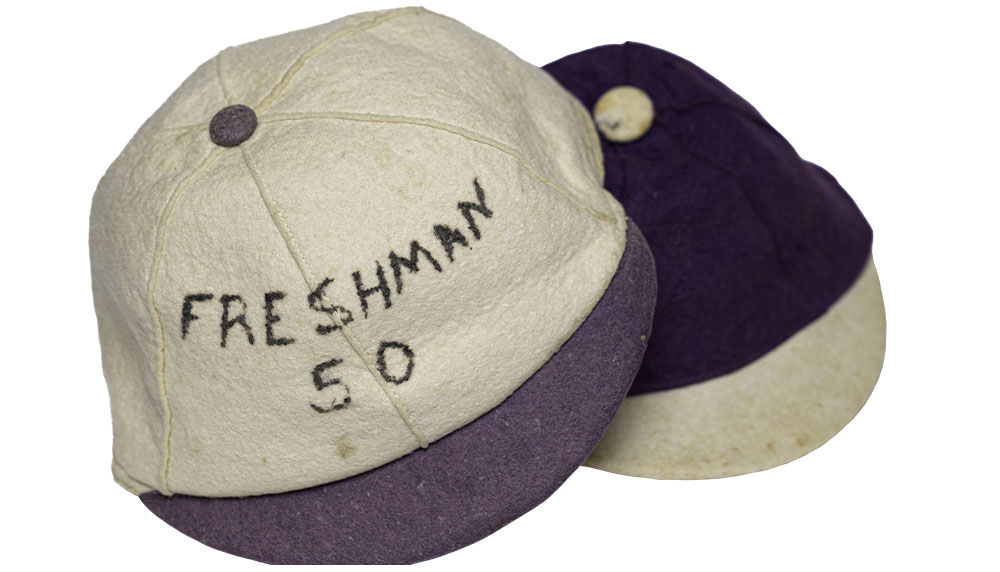
The tradition of wearing beanies was widespread among higher education institutions from the late 19th century until the mid-20th century. All first-year students were expected to wear their beanies — or bonnets, if women preferred — from sunup to sundown except on Sundays.
At SFA, the tradition can be seen in first-year student photographs from the late 1930s until the mid-1960s. The tradition was started by student Bergman "Boots" Morrison who ordered 300 beanies. These were then sold to first-year students at a cost of $0.25 for women and $0.35 for men. First-year students caught without beanies were fined the cost of a beanie. Beanies were used to quickly identify who was a first-year student on campus. Students had mixed feelings about the tradition, with some saying it created a shared experience while others thought it made it easier for first-year students to get picked on.
King's Men Papers
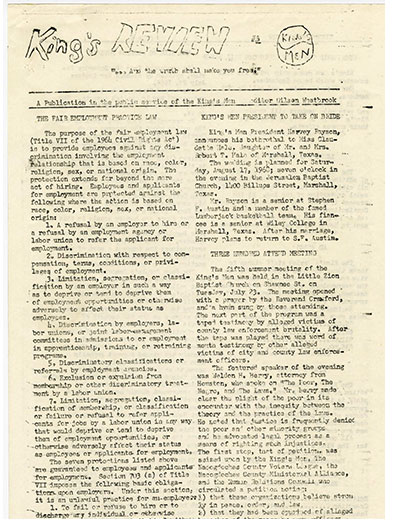
The King's Men was an organization created after the assassination of Dr. Martin Luther King Jr. in 1968. The group was formed in April 1968 with the mission of "gaining equality for everyone through peaceful means" as King had advocated. The group participated in protests to desegregate a local washeteria and skating rink and to boycott downtown businesses that refused to serve Black Americans. The group was made up of faculty, staff and students at SFA.
The group also published a regular independent newsletter called the King's Review, pictured, that let people know about upcoming events and how to properly file complaints when a person felt their civil rights were violated, as well as compiled addresses to send complaints to when the 1964 Civil Rights Act was violated. The purpose of the King's Review was "to bring awareness in the population of Nacogdoches of the problems that face the destruction of the American creed, 'All men are created equal'."
View issues of the King's Review on the East Texas Digital Archives
1949 Lumberjack Marching Band Mascot Uniform
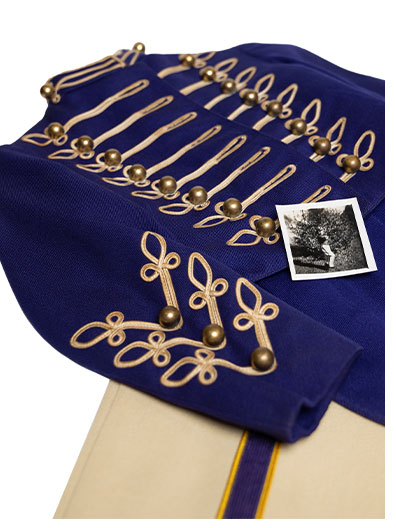
This tiny uniform was made for Joan Stallings Leach '65 of Fredericksburg, who donated it to the SFA archives in 2019. The uniform is nearly an exact replica — in miniature — of the band uniforms worn by the SFA band during the late 1940s and early 1950s.
Leach was 4 years old when she became the band mascot in 1949. J.T. Cox was the band director at the time. Leach remained the mascot for a few years while she and her family attended almost every SFA football and basketball game while she was in Nacogdoches. Leach's mother was an SFA alumna and worked on campus in various positions for 50 years. Leach attended the demonstration school on campus as a child.
Vietnam Anti-War Posters
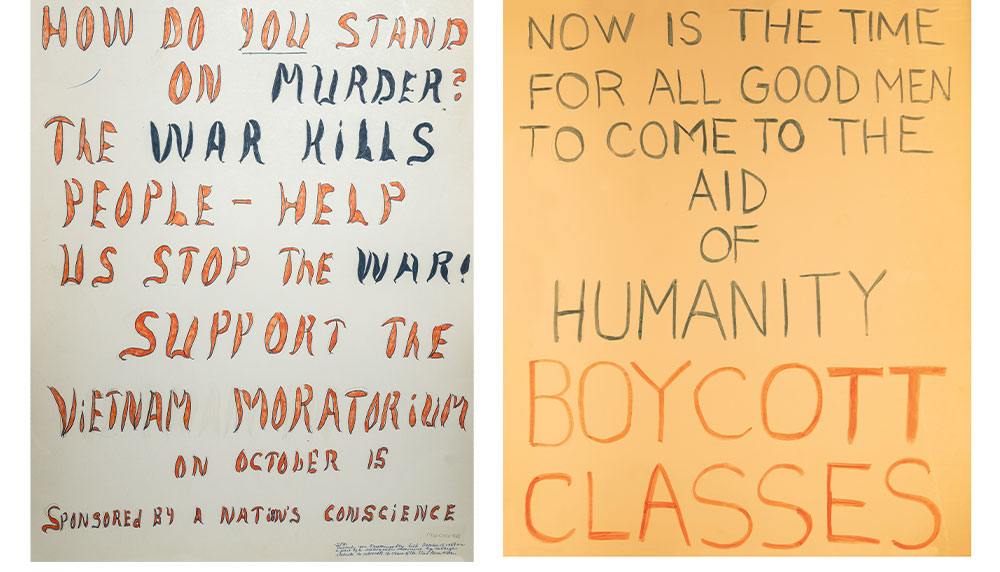
These posters were created by students for student-organized protests of the Vietnam War on SFA's campus. The protest events were organized by the League for Student Involvement, which also petitioned for free speech on and off campus, held a teach-in on Nixon's decision to bomb Cambodia, and helped coordinate Earth Day with other student organizations. The largest protest event occurred Oct. 15, 1969, in conjunction with the Nationwide Moratorium to End the War in Vietnam Day.
On this day, a bell was rung once for every Texan killed in Vietnam, and organized protests occurred across the nation on many campuses. Another large protest occurred Nov. 15, 1969, to coincide with a march in Washington, D.C. Monthly demonstrations continued throughout the school year against the war.
Lumberjack Mascot Boots
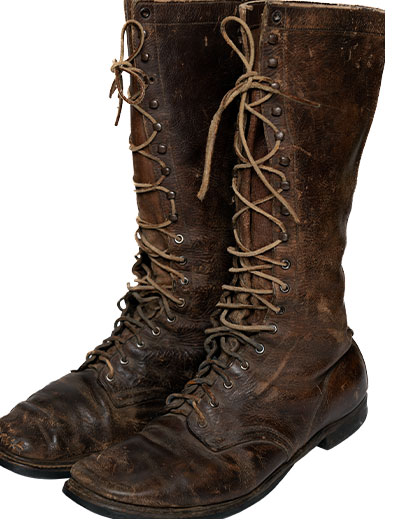
These boots were donated by Steve Whitbeck '75 who served as Lumberjack mascot in 1972. Whitbeck was also a Lumberjack cheerleader for two years. In September 2019, he was recognized at the Alumni Association Awards Banquet with the Lumberjack Pride Award.
The official Lumberjack mascot of SFA was selected by students, faculty and staff in 1923. The name was put forward by T.E. Ferguson, an English professor. The Lumberjack represents SFA at athletic, civic and off-campus events. In fact, during the Jacks' 2014 NCAA basketball tournament appearance, our Lumberjack was one of the most talked about aspects of SFA. The appearance of a physical mascot did not start until the 1960s, and this was primarily at Homecoming parades and games or on Lumberjack Days, an event hosted by the Sylvans. Lumberjack Days included allowing students to watch or participate in double buck log sawing, log chopping, caber toss, tug of war and axe throwing. Usually, the event took place around Homecoming and had a very large participation rate among student groups.
From SFA's beginning, most school spirit and pep activities were led by male and female cheerleaders. Male cheerleaders were also regularly referred to as yell leaders. Starting in the late 1960s, it was much more common to see a Lumberjack mascot at official SFA events. Starting in the early 1970s, there was also an accompanying female mascot called the Ladyjack who attended all the events alongside the Lumberjack.
Lumberjack Mascot Axe

This donation is from Steve Whitbeck '75, who served as the Lumberjack mascot in 1972. Iterations of this axe are still used by the Lumberjack mascot today.
Poultry Bowl Signed Football
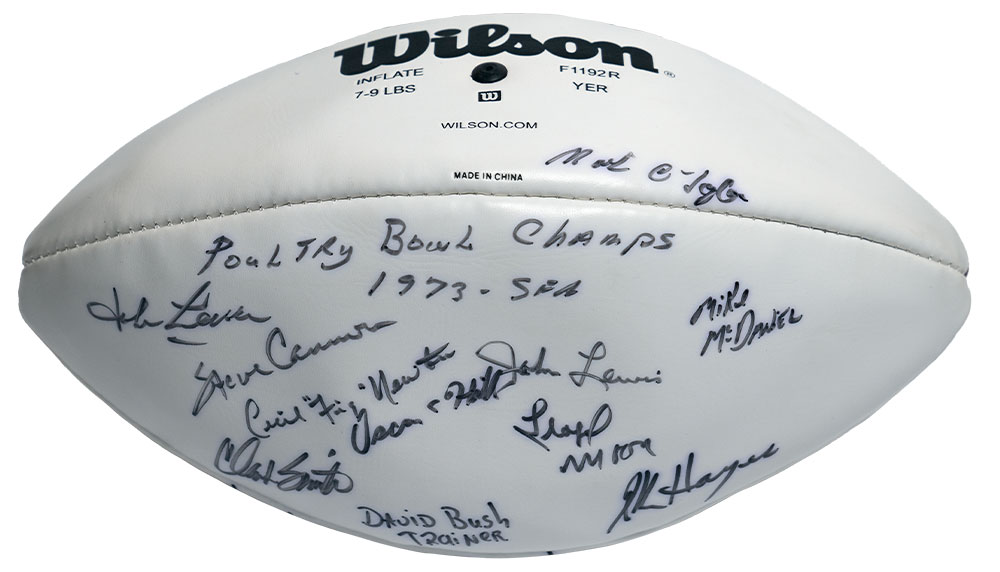
The Poultry Bowl was a short-lived college football bowl game played in 1973 and 1974. The bowl game was created for smaller colleges that couldn't participate in the major bowl games. SFA was invited to the Poultry Bowl after finishing third in the Lone Star Conference. The 1973 Bowl was played in Gainesville, Georgia, between SFA and Gardner-Webb University. SFA won the game 31-10 on Dec. 8, 1973. That season was one of SFA's most successful, setting a season win record of eight victories, six of which came in conference play. SFA also set the team's individual rushing yards record in a game with Larry Mayer gaining 237 yards in the bowl game.
Cafeteria Tray
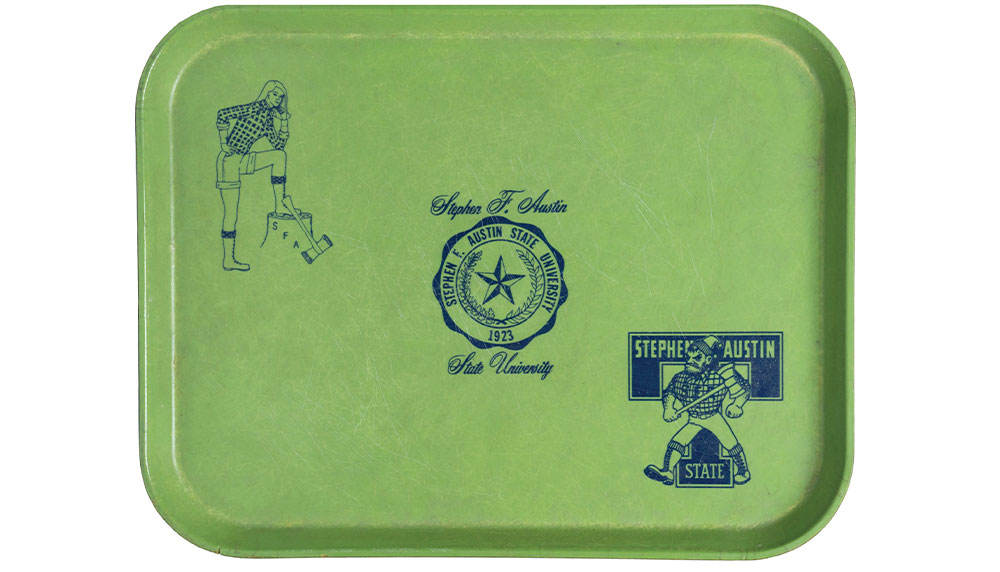
The tray, known as a Camtray, is from the 1970s or 1980s. It is made of fiberglass and is manufactured by Cambro, a company that still makes fiberglass cafeteria trays. The tray was used in the East College Cafeteria, which was SFA's most modern and state-of-the-art dining facility upon completion in 1966. It was designed to show off the unique mid-century architectural style and became a centerpiece of the growth of SFA during the 1960s and 1970s.
Steen Hall, situated across the street from the cafeteria, and later Garner Hall, a dorm that was razed in 2010, were all designed to complement each other architecturally. The East College Cafeteria, along with the Steen and Garner halls, were often the most recognizable buildings on campus due to their distinct architectural style.
President's Bible
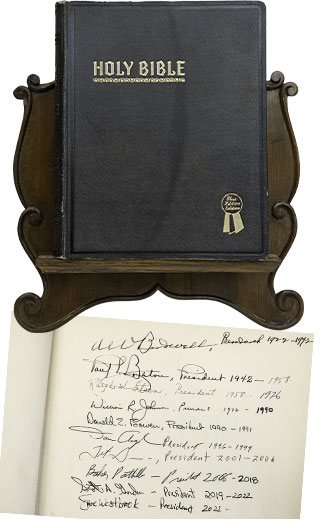
The President's Bible contains the signatures of SFA's 10 presidents and is displayed in the president's office. Each SFA president was sworn into office on this Bible. SFA's past presidents include:
- Dr. Alton Birdwell, 1917-42
- Dr. Paul L. Boynton, 1942-58
- Dr. Ralph W. Steen, 1958-76
- Dr. William R. Johnson, 1976-90
- Dr. Donald Bowen, 1990-91
- Dr. Dan Angel, 1992-99
- Dr. Tito Guerrero, 2001-06
- Dr. Baker Pattillo, 2006-18
- Dr. Scott Gordon, 2019-22
- and Dr. Steve Westbrook, 2023.
Football Programs (Late '50s to Mid '60s)
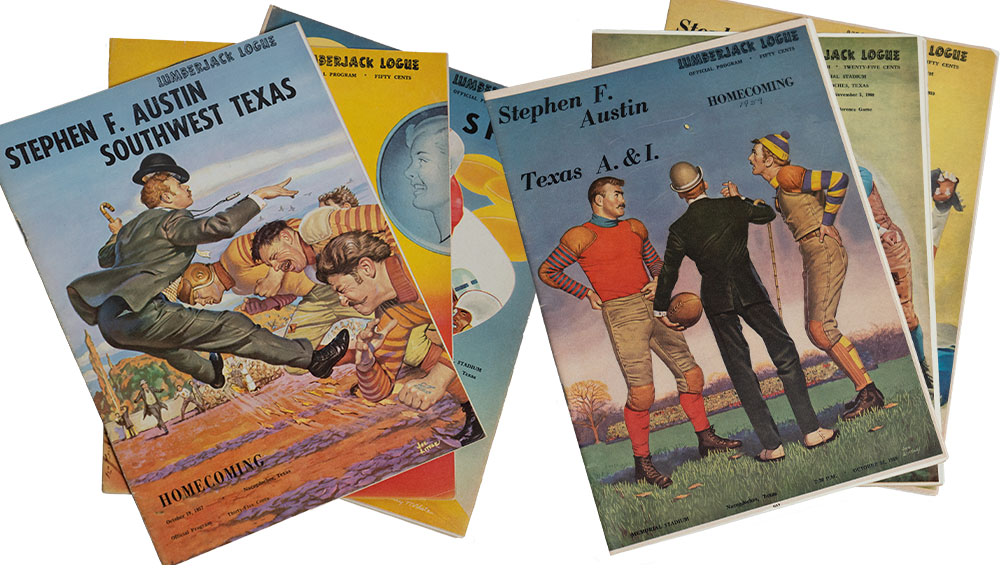
During the post-war era, football games were must-attend events for SFA students, faculty, staff and the Nacogdoches community. Every social club or Greek organization usually had designated seating areas staked out in the stands. The football programs used Norman-Rockwell-style images on the front, which was an extremely popular art style during this time.
The images were licensed from artists like Joe Little, Gil Evergreen, Fred Fixler and Larry Tisdale. These same images can be found on NFL and other college football programs from the time. Though not every program featured SFA's iconic purple and white, these football programs truly are works of art that created both a sense of nostalgia for the pre-war era and post-war optimism. Students would regularly put the covers of winning games on their walls as cheap wall art and a way to remember the victories of the Lumberjacks.
Willie Nelson Poster and Paul Buskirk Mandola
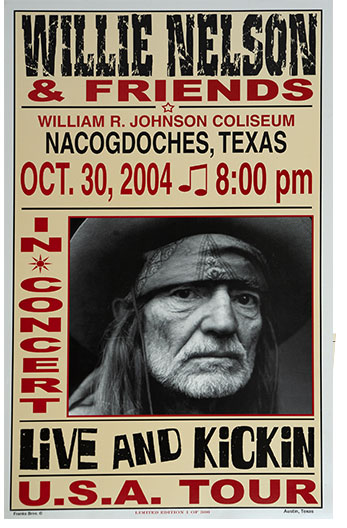
Paul Buskirk (1924-2002) was a musician famous for his mandolin, guitar and banjo abilities. Buskirk appeared on the Grand Ole Opry stage and worked with prominent musicians like Chet Atkins, Tex Ritter, Lefty Frizzell, Ray Price, Rex Allen and Willie Nelson. Nelson credited Buskirk with teaching him all he knew about playing guitar, and they formed a lifelong professional and personal relationship. Buskirk helped produce and performed on some of Nelson's albums.
In 1992, Nelson returned the favor and helped produce Buskirk's record, "Nacogdoches Waltz." Legend has it that Nelson played Buskirk's mandola during these recording sessions. Buskirk donated his estate to SFA after his death to help fund the Paul Buskirk Memorial Scholarship. The scholarship is intended for native Texans who are music majors and play a string instrument. After the death of Buskirk, Nelson played a benefit concert for the Buskirk Scholarship on Oct. 30, 2004, in Johnson Coliseum. The mandola donated by Buskirk is a custom-built piece that was on display at the Pearman Alumni Center for many years.
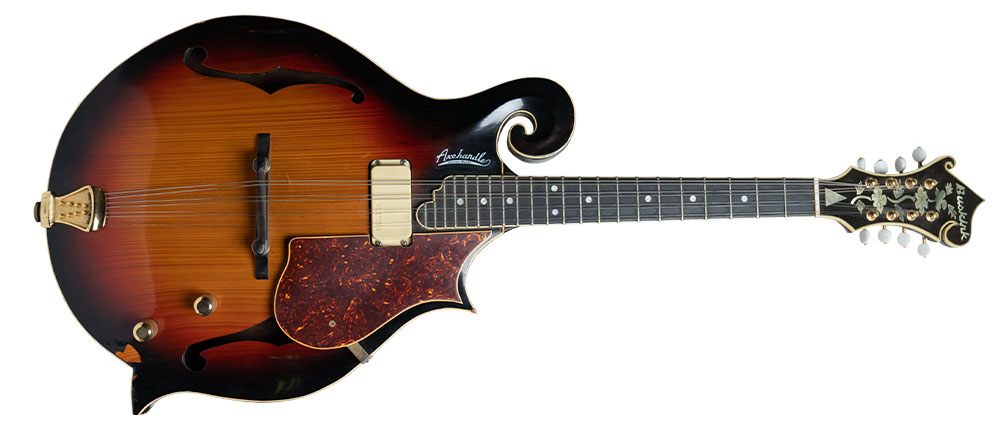

 Axe ’Em, Jacks!
Axe ’Em, Jacks!